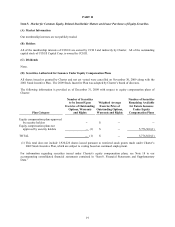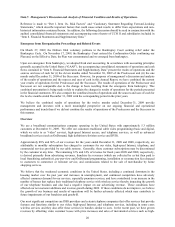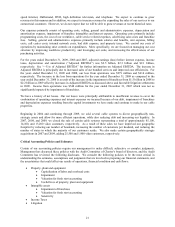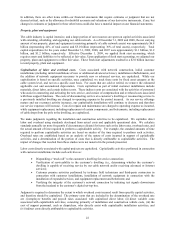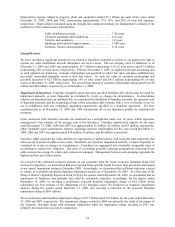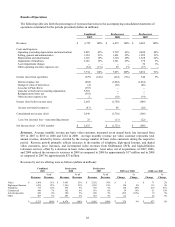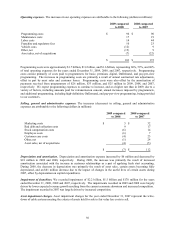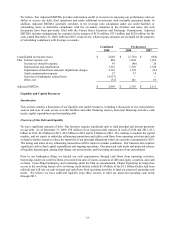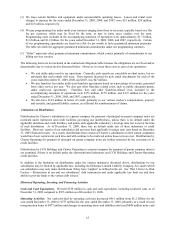Charter 2009 Annual Report Download - page 29
Download and view the complete annual report
Please find page 29 of the 2009 Charter annual report below. You can navigate through the pages in the report by either clicking on the pages listed below, or by using the keyword search tool below to find specific information within the annual report.
26
discount rate in assessing the fair value of our intangible assets at November 30, 2009 that was 1% higher across all
units of accounting (holding all other assumptions unchanged) the fair value of our franchises and customer
relationships would have decreased by approximately $1.1 billion and $280 million, respectively. Had we used a
discount rate that was 1% lower, the fair value of our franchises and customer relationships would have increased by
approximately $1.5 billion and $321 million, respectively.
Income Taxes
All operations are held through Charter Holdco and its direct and indirect subsidiaries. Charter Holdco and the
majority of its subsidiaries are generally limited liability companies that are not subject to income tax. However,
certain of these limited liability companies are subject to state income tax. In addition, the subsidiaries that are
corporations are subject to federal and state income tax. All of the remaining taxable income, gains, losses,
deductions and credits of Charter Holdco pass through to its members.
The LLC agreement that governed Charter Holdco prior to its emergence from bankruptcy contained special loss
and income allocation provisions. Pursuant to the operation of these provisions and applicable U.S. federal income
tax law, the cumulative amount of losses of Charter Holdco allocated to Vulcan Cable III, Inc., an entity owned by
Mr. Allen and subsequently merged into CII, and CII was in excess of the amount that would have been allocated to
such entities if the losses of Charter Holdco had been allocated among its members in proportion to their respective
percentage ownership of Charter Holdco common membership units.
Effective with Charter’ s emergence from bankruptcy on November 30, 2009, Charter Holdco’ s LLC Agreement was
amended such that section 704(b) book income and loss are to be allocated among the members of Charter Holdco
such that the members’ capital accounts are adjusted as nearly as possible to reflect the amount that each member
would have received if Charter Holdco were liquidated at section 704(b) book values. The allocation of taxable
income and loss should follow the section 704(b) book allocations and generally reflect the member’ s respective
percentage ownership of Charter Holdco common membership interests, except to the extent of certain required
allocations pursuant to section 704(c) of the Internal Revenue Code.
In connection with the Plan, Charter, CII, Mr. Allen and Charter Holdco entered into an exchange agreement (the
“Exchange Agreement”), pursuant to which CII had the right to require Charter to (i) exchange all or a portion of
CII’ s membership interest in Charter Holdco or 100% of CII for $1,000 in cash and shares of Charter’ s Class A
common stock in a taxable transaction, or (ii) merge CII with and into Charter, or a wholly-owned subsidiary of
Charter, in a tax-free transaction (or undertake a tax-free transaction similar to the taxable transaction in subclause
(i)), subject to CII meeting certain conditions. In addition, Charter had the right, under certain circumstances
involving a change of control of Charter to require CII to effect an exchange transaction of the type elected by CII
from subclauses (i) or (ii) above, which election is subject to certain limitations.
On December 28, 2009, CII exercised its right, under the Exchange Agreement with Charter, to exchange 81% of its
common membership interest in Charter Holdco for $1,000 in cash and 907,698 shares of Charter’ s Class A
common stock in a fully taxable transaction. Charter’ s deferred tax liability increased by $100 million as a result of
the transaction. Charter also received a step-up in tax basis in Charter Holdco’ s assets, under section 743 of the
Code, relative to the interest in Charter Holdco it acquired from CII. Based upon the taxable exchange which
occurred on December 28, 2009, CII fulfilled the conditions necessary to allow it to elect a tax-free transaction at
any time during the remaining term of the Exchange Agreement. On February 8, 2010, the remaining interest was
exchanged after which Charter Holdco became 100% owned by Charter and ownership of CII was transferred to
Charter. As a result, in the first quarter of 2010, Charter’ s deferred tax liabilities will be increased relative to the
taxable gain inherent in CII’ s previous .19% Charter Holdco interest.
As of December 31, 2009, Charter had approximately $6.3 billion of federal tax net operating losses, resulting in a
gross deferred tax asset of approximately $2.2 billion, expiring in the years 2014 through 2028. These losses arose
from the operation of Charter Holdco and its subsidiaries. In addition, as of December 31, 2009, Charter had state
tax net operating losses, resulting in a gross deferred tax asset (net of federal tax benefit) of approximately $209
million, generally expiring in years 2010 through 2028. Due to uncertainties in projected future taxable income,
valuation allowances have been established against the gross deferred tax assets for book accounting purposes,
except for deferred benefits available to offset certain deferred tax liabilities. Such tax net operating losses can
accumulate and be used to offset Charter’ s future taxable income. The consummation of the Plan generated an
“ownership change” as defined in Section 382 of the Code. As a result, Charter is subject to an annual limitation on
the use of its net operating losses. Further, Charter’ s net operating loss carryforwards have been reduced by the
amount of the cancellation of debt income resulting from the Plan that was allocable to Charter. The limitation on





